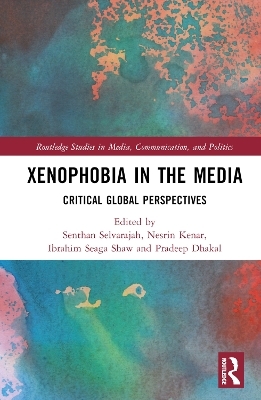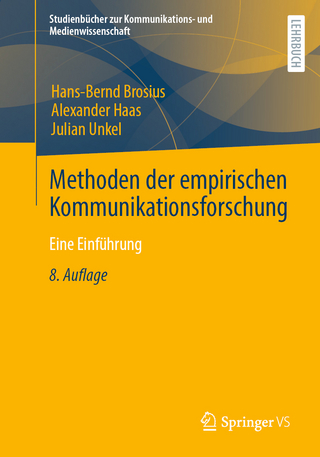
Xenophobia in the Media
Routledge (Verlag)
978-1-032-55703-8 (ISBN)
Through its global and critical perspectives, this book brings together knowledge, ideas and tools to understand the problems and identify effective solutions, best practices and alternative approaches to combat xenophobia in the media and build tolerance and social cohesion.
Although various studies have been conducted on the extent to which the media construct xenophobic discourse against immigrants and refugees and how they represent immigrants, there exists a research lacuna as to the dynamics of the xenophobia construction in the media; the effect of xenophobic discourse of the media and its function; the nexus between xenophobia construction of the media and the social, economic and political conditions; and the impact of the xenophobic discourse of the media on immigrants and host communities. This book adds knowledge and empirical evidence to fill this research gap.
This book will be an important resource for journalists, scholars and students of media and communication studies, journalism, political science, sociology and anyone covering issues of race and racism, human rights, immigration and refugees.
Senthan Selvarajah is a co-director at the Centre for Media, Human Rights and Peacebuilding, UK; CEO at the Gate Foundation, UK; and a PhD supervisor for Unicaf University students. Nesrin Kenar is an associate professor at the Faculty of Political Sciences, Sakarya University, Turkey, and a co-director of the Centre for Media, Human Rights and Peacebuilding, UK. She was the former vice dean of the Faculty of Political Sciences at Sakarya University. Ibrahim Seaga Shaw is the chairman/information commissioner of Right to Access Information Commission; the coordinator of the Graduate Program at the Faculty of Communication, Media, and Information Studies, Fourah Bay College, University of Sierra Leone; and a co-director at the Centre for Media, Human Rights and Peacebuilding, UK. Pradeep Dhakal is a co-director at the Centre for Media, Human Rights and Peacebuilding, UK; and a director of Chetanalaya Institute, Nepal. Before that, he was a lecturer at Tribhuvan University, Nepal.
Chapter 1: Xenophobic Portrayal of Immigrants and Refugees and Threat Image Construction in the Media: An Introduction
Part 1: Principles and Practise of Journalism of Tolerance
Chapter 2: Reporting Syrian refugees in Turkey: the myths, the facts, and human rights journalism
Chapter 3: Journalism of Tolerance: Reporting About Refugees and Immigrants
Chapter 4: Xenophobia in the Media and Turkish Management of Syrian Refugees: Applications of Lessons on Afghan Refugees and Ukrainian Immigrants
Part 2: Media Stereotyping of Minorities and Women
Chapter 5: Immoral Image of Emigrant Women: A Distanced-Marginalised Self?
Chapter 6: The Dangers of the Syrian Woman from the Lens of Mainstream Turkish Media Outlets
Chapter 7: Displacement, Citizenship and Media: A Sociological Study of Paroja Tribe and its Identity Construction
Chapter 8: The nexus between xenophobia and GBV: A qualitative inquiry on African migrant women’s lived experiences in Durban, South Africa
Part 3: Politics of Xenophobia and Portrayal of Enemy Image
Chapter 9: Discrimination, Criminalisation and Xenophobia in the Media: the case of Venezuelan Migration in Brazil, Colombia, Ecuador, and Peru
Chapter 10: ‘Aliens are here to destroy us’ – Xenophobia and the Art of Headlining in South African Media
Chapter 11: Throwing Stones in still ponds: the nexus between Xenophobia and Afrophobia and the Instrumentalisation of the Media in Cȏte d’Ivoire and post-Apartheid South Africa
Part 4: Social Media and Xenophobia
Chapter 12: Interplays between Anti-Islam and Anti-Migration Sentiments in the Turkish Context
Chapter 13: Hate Speech on Facebook and Its Implications on National Unity in Cameroon
Chapter 14: The criminalisation of migration in South Africa: An exploration of Operation Dudula and Fiela from a social media perspective
Chapter 15: Anti-immigrant attitudes and social media use: An empirical study on xenophobia in North Macedonia
| Erscheinungsdatum | 02.02.2024 |
|---|---|
| Reihe/Serie | Routledge Studies in Media, Communication, and Politics |
| Zusatzinfo | 11 Tables, black and white; 4 Line drawings, black and white; 1 Halftones, black and white; 5 Illustrations, black and white |
| Verlagsort | London |
| Sprache | englisch |
| Maße | 156 x 234 mm |
| Gewicht | 648 g |
| Themenwelt | Kunst / Musik / Theater |
| Sozialwissenschaften ► Kommunikation / Medien ► Kommunikationswissenschaft | |
| Sozialwissenschaften ► Kommunikation / Medien ► Medienwissenschaft | |
| ISBN-10 | 1-032-55703-6 / 1032557036 |
| ISBN-13 | 978-1-032-55703-8 / 9781032557038 |
| Zustand | Neuware |
| Informationen gemäß Produktsicherheitsverordnung (GPSR) | |
| Haben Sie eine Frage zum Produkt? |
aus dem Bereich


